Millikin student creates carbon electrodes using 3D printing
Carbon electrodes are a key component of electrochemistry. They are used for many electrochemical applications, ranging from investigating neurotransmitter movement in a brain to toxin detection in lake water.
Currently, many carbon electrodes are prepared in cleanrooms using expensive technologies such as photolithography, but what if customizable carbon electrodes could be made using 3-D printing? The research team of Dalton Glasco, a senior chemistry major at Millikin University, and Dr. Kyle Knust, assistant professor of chemistry, are spending the summer developing a simple and accessible strategy to make this happen.
Dr. Knust and Glasco are among several student-professor partnerships this summer conducting research as part of Millikin's Summer Undergraduate Research Fellowship (SURF) program. The work to develop the carbon electrodes using 3-D printing was started by Glasco in 2018.
"Dalton is working on an alternative fabrication route for preparing pyrolyzed carbon electrodes," said Knust. "The goal is to prepare an electrode that mimics glassy carbon which is a material that electrochemists like to use for a diversity of applications."
As part of his research, Glasco is using a computer software to create carbon electrode designs, which are then 3-D printed directly onto quartz using a carbon rich resin. The electrode is then transferred to a tube furnace and pyrolyzed – a process where material decomposition is heated to extreme temperatures.
"It provides a lower cost, more accessible route to preparing a customizable glassy carbon-type electrode," said Knust. "Instead of requiring a cleanroom and the infrastructure in the cleanroom, techniques like photolithography with a desktop 3-D printer – such as ours, and a tube furnace, you can prepare these electrodes yourself."
According to Knust, the 3-D printer used for this research costs $3,500, while a Class 1000 cleanroom can easily exceed $100,000. The costs of using equipment within a cleanroom can also increase the cost of producing the electrodes.




